Construction Procurement & Contractual Procedures Report: Part 1
VerifiedAdded on 2020/07/22
|19
|6644
|51
Report
AI Summary
This report provides a comprehensive analysis of contractual procedures and procurement methods within the construction and built environment sectors. It begins by addressing the client's needs in the construction process, differentiating between public and private sector considerations, and examining factors like design, price certainty, complexity, quality, deadlines, and profit. The report then delves into the issues surrounding the selection of different procurement arrangements, contrasting traditional and non-traditional methods, and highlighting their respective advantages and disadvantages. A key component of the report is the comparison of various contract forms, including lump sum, re-measurement, and term contracts, detailing their characteristics and suitability. Furthermore, it explores current trends in construction procurement practices, specifically focusing on the Hong Kong market and the government's adoption of new engineering contracts. Finally, the report outlines the contractual relationships within a traditional procurement system, defining roles and responsibilities, and clarifying the organizational purposes and activities involved in the procurement process. This is a student submission provided on Desklib, a platform for AI-powered study tools and resources.
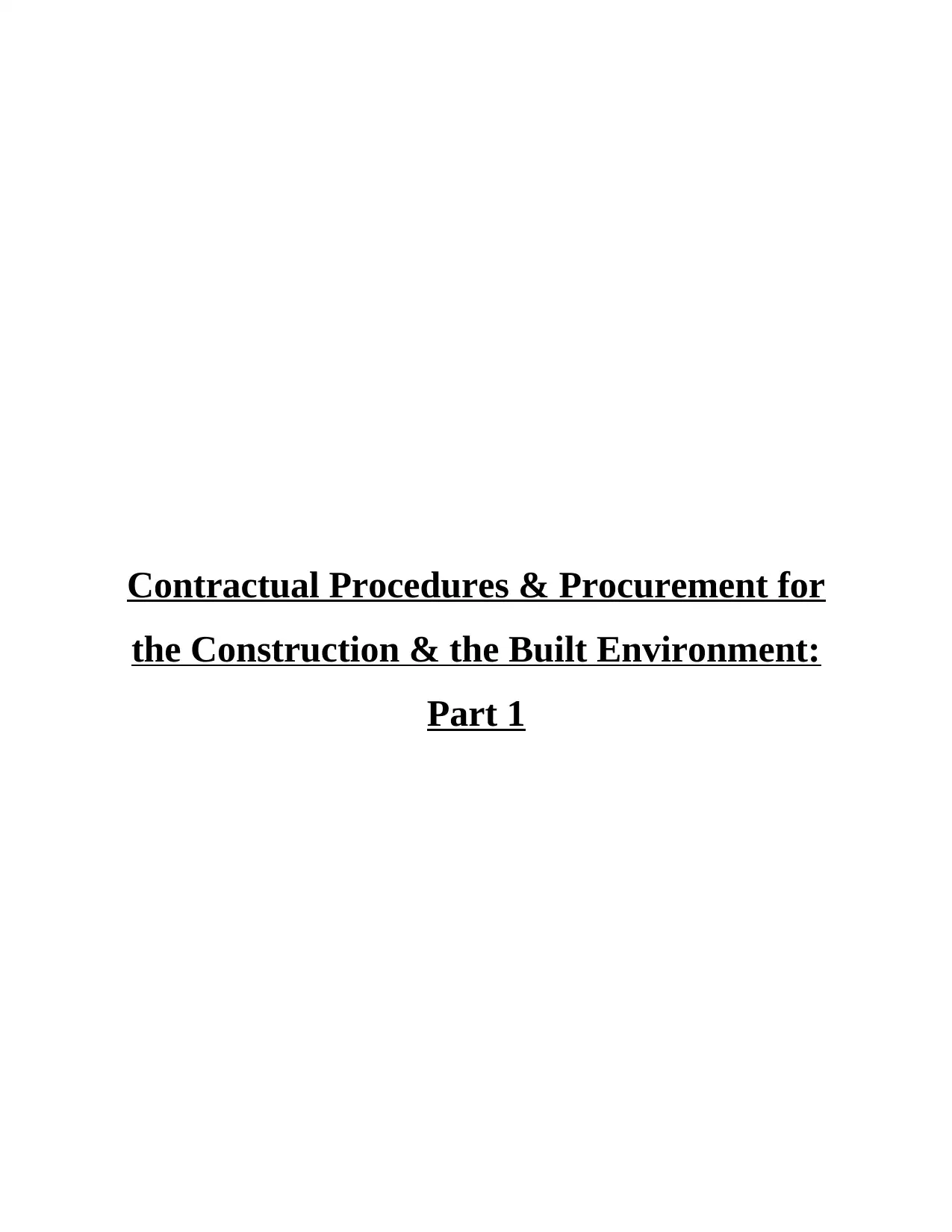
Contractual Procedures & Procurement for
the Construction & the Built Environment:
Part 1
the Construction & the Built Environment:
Part 1
Paraphrase This Document
Need a fresh take? Get an instant paraphrase of this document with our AI Paraphraser
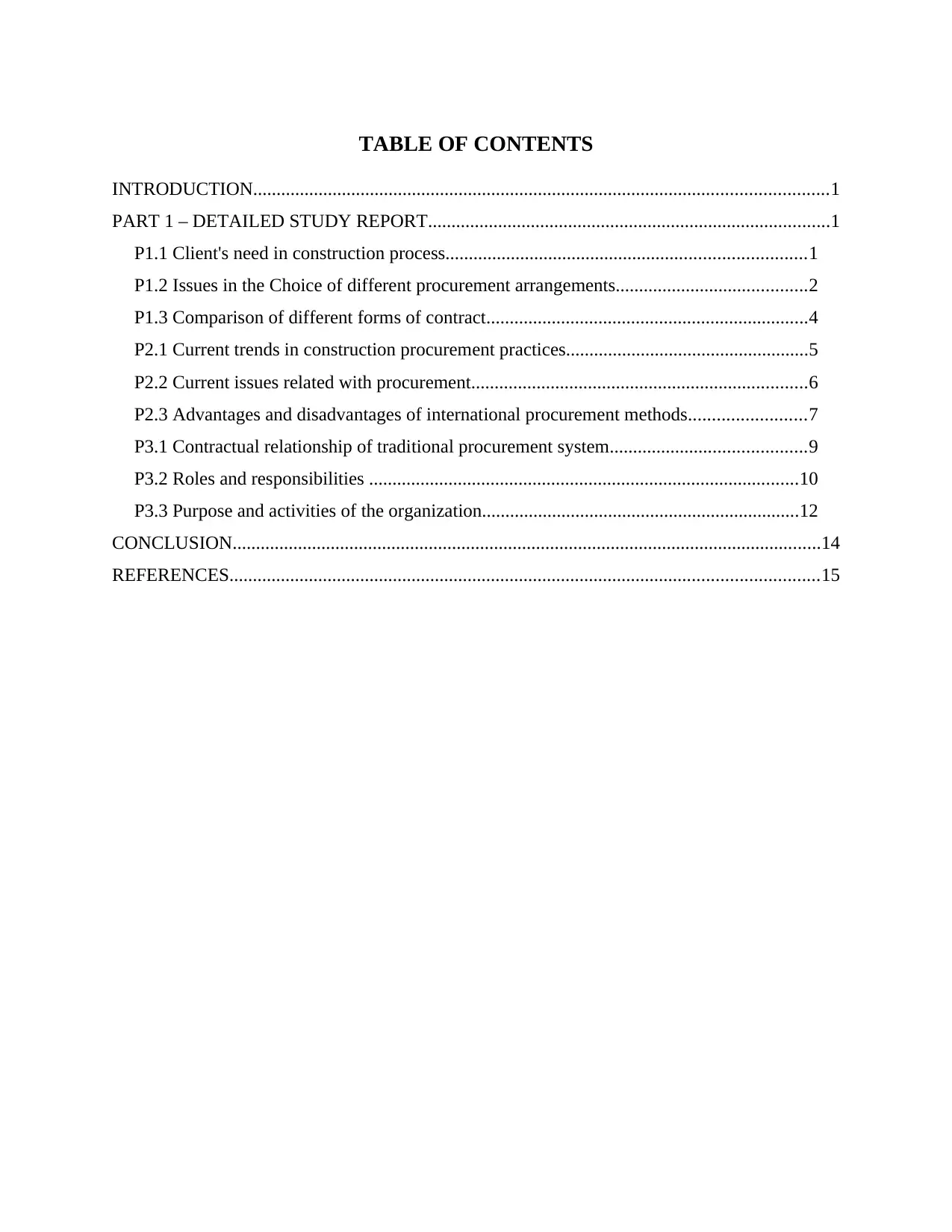
TABLE OF CONTENTS
INTRODUCTION...........................................................................................................................1
PART 1 – DETAILED STUDY REPORT......................................................................................1
P1.1 Client's need in construction process.............................................................................1
P1.2 Issues in the Choice of different procurement arrangements.........................................2
P1.3 Comparison of different forms of contract.....................................................................4
P2.1 Current trends in construction procurement practices....................................................5
P2.2 Current issues related with procurement........................................................................6
P2.3 Advantages and disadvantages of international procurement methods.........................7
P3.1 Contractual relationship of traditional procurement system..........................................9
P3.2 Roles and responsibilities ............................................................................................10
P3.3 Purpose and activities of the organization....................................................................12
CONCLUSION..............................................................................................................................14
REFERENCES..............................................................................................................................15
INTRODUCTION...........................................................................................................................1
PART 1 – DETAILED STUDY REPORT......................................................................................1
P1.1 Client's need in construction process.............................................................................1
P1.2 Issues in the Choice of different procurement arrangements.........................................2
P1.3 Comparison of different forms of contract.....................................................................4
P2.1 Current trends in construction procurement practices....................................................5
P2.2 Current issues related with procurement........................................................................6
P2.3 Advantages and disadvantages of international procurement methods.........................7
P3.1 Contractual relationship of traditional procurement system..........................................9
P3.2 Roles and responsibilities ............................................................................................10
P3.3 Purpose and activities of the organization....................................................................12
CONCLUSION..............................................................................................................................14
REFERENCES..............................................................................................................................15

⊘ This is a preview!⊘
Do you want full access?
Subscribe today to unlock all pages.

Trusted by 1+ million students worldwide
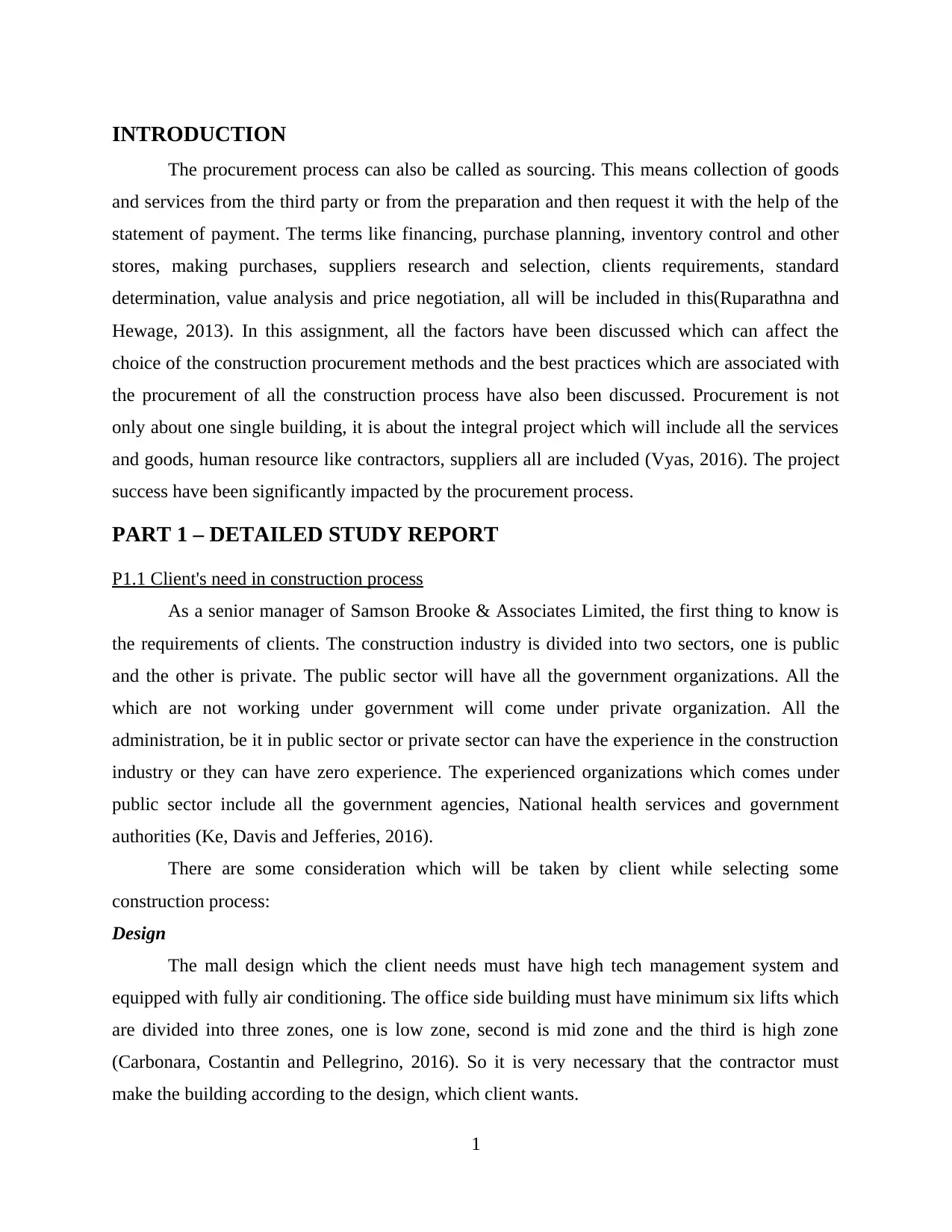
INTRODUCTION
The procurement process can also be called as sourcing. This means collection of goods
and services from the third party or from the preparation and then request it with the help of the
statement of payment. The terms like financing, purchase planning, inventory control and other
stores, making purchases, suppliers research and selection, clients requirements, standard
determination, value analysis and price negotiation, all will be included in this(Ruparathna and
Hewage, 2013). In this assignment, all the factors have been discussed which can affect the
choice of the construction procurement methods and the best practices which are associated with
the procurement of all the construction process have also been discussed. Procurement is not
only about one single building, it is about the integral project which will include all the services
and goods, human resource like contractors, suppliers all are included (Vyas, 2016). The project
success have been significantly impacted by the procurement process.
PART 1 – DETAILED STUDY REPORT
P1.1 Client's need in construction process
As a senior manager of Samson Brooke & Associates Limited, the first thing to know is
the requirements of clients. The construction industry is divided into two sectors, one is public
and the other is private. The public sector will have all the government organizations. All the
which are not working under government will come under private organization. All the
administration, be it in public sector or private sector can have the experience in the construction
industry or they can have zero experience. The experienced organizations which comes under
public sector include all the government agencies, National health services and government
authorities (Ke, Davis and Jefferies, 2016).
There are some consideration which will be taken by client while selecting some
construction process:
Design
The mall design which the client needs must have high tech management system and
equipped with fully air conditioning. The office side building must have minimum six lifts which
are divided into three zones, one is low zone, second is mid zone and the third is high zone
(Carbonara, Costantin and Pellegrino, 2016). So it is very necessary that the contractor must
make the building according to the design, which client wants.
1
The procurement process can also be called as sourcing. This means collection of goods
and services from the third party or from the preparation and then request it with the help of the
statement of payment. The terms like financing, purchase planning, inventory control and other
stores, making purchases, suppliers research and selection, clients requirements, standard
determination, value analysis and price negotiation, all will be included in this(Ruparathna and
Hewage, 2013). In this assignment, all the factors have been discussed which can affect the
choice of the construction procurement methods and the best practices which are associated with
the procurement of all the construction process have also been discussed. Procurement is not
only about one single building, it is about the integral project which will include all the services
and goods, human resource like contractors, suppliers all are included (Vyas, 2016). The project
success have been significantly impacted by the procurement process.
PART 1 – DETAILED STUDY REPORT
P1.1 Client's need in construction process
As a senior manager of Samson Brooke & Associates Limited, the first thing to know is
the requirements of clients. The construction industry is divided into two sectors, one is public
and the other is private. The public sector will have all the government organizations. All the
which are not working under government will come under private organization. All the
administration, be it in public sector or private sector can have the experience in the construction
industry or they can have zero experience. The experienced organizations which comes under
public sector include all the government agencies, National health services and government
authorities (Ke, Davis and Jefferies, 2016).
There are some consideration which will be taken by client while selecting some
construction process:
Design
The mall design which the client needs must have high tech management system and
equipped with fully air conditioning. The office side building must have minimum six lifts which
are divided into three zones, one is low zone, second is mid zone and the third is high zone
(Carbonara, Costantin and Pellegrino, 2016). So it is very necessary that the contractor must
make the building according to the design, which client wants.
1
Paraphrase This Document
Need a fresh take? Get an instant paraphrase of this document with our AI Paraphraser
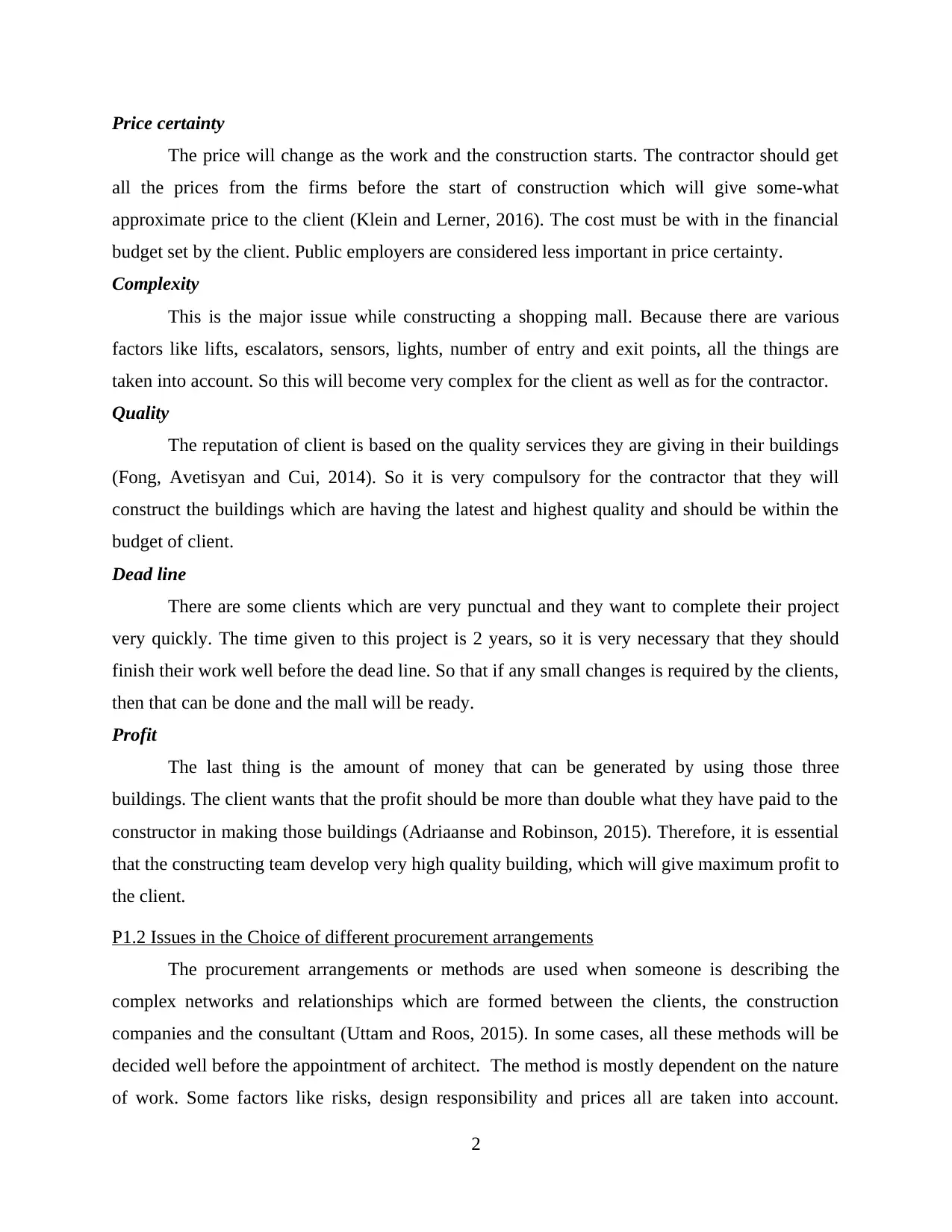
Price certainty
The price will change as the work and the construction starts. The contractor should get
all the prices from the firms before the start of construction which will give some-what
approximate price to the client (Klein and Lerner, 2016). The cost must be with in the financial
budget set by the client. Public employers are considered less important in price certainty.
Complexity
This is the major issue while constructing a shopping mall. Because there are various
factors like lifts, escalators, sensors, lights, number of entry and exit points, all the things are
taken into account. So this will become very complex for the client as well as for the contractor.
Quality
The reputation of client is based on the quality services they are giving in their buildings
(Fong, Avetisyan and Cui, 2014). So it is very compulsory for the contractor that they will
construct the buildings which are having the latest and highest quality and should be within the
budget of client.
Dead line
There are some clients which are very punctual and they want to complete their project
very quickly. The time given to this project is 2 years, so it is very necessary that they should
finish their work well before the dead line. So that if any small changes is required by the clients,
then that can be done and the mall will be ready.
Profit
The last thing is the amount of money that can be generated by using those three
buildings. The client wants that the profit should be more than double what they have paid to the
constructor in making those buildings (Adriaanse and Robinson, 2015). Therefore, it is essential
that the constructing team develop very high quality building, which will give maximum profit to
the client.
P1.2 Issues in the Choice of different procurement arrangements
The procurement arrangements or methods are used when someone is describing the
complex networks and relationships which are formed between the clients, the construction
companies and the consultant (Uttam and Roos, 2015). In some cases, all these methods will be
decided well before the appointment of architect. The method is mostly dependent on the nature
of work. Some factors like risks, design responsibility and prices all are taken into account.
2
The price will change as the work and the construction starts. The contractor should get
all the prices from the firms before the start of construction which will give some-what
approximate price to the client (Klein and Lerner, 2016). The cost must be with in the financial
budget set by the client. Public employers are considered less important in price certainty.
Complexity
This is the major issue while constructing a shopping mall. Because there are various
factors like lifts, escalators, sensors, lights, number of entry and exit points, all the things are
taken into account. So this will become very complex for the client as well as for the contractor.
Quality
The reputation of client is based on the quality services they are giving in their buildings
(Fong, Avetisyan and Cui, 2014). So it is very compulsory for the contractor that they will
construct the buildings which are having the latest and highest quality and should be within the
budget of client.
Dead line
There are some clients which are very punctual and they want to complete their project
very quickly. The time given to this project is 2 years, so it is very necessary that they should
finish their work well before the dead line. So that if any small changes is required by the clients,
then that can be done and the mall will be ready.
Profit
The last thing is the amount of money that can be generated by using those three
buildings. The client wants that the profit should be more than double what they have paid to the
constructor in making those buildings (Adriaanse and Robinson, 2015). Therefore, it is essential
that the constructing team develop very high quality building, which will give maximum profit to
the client.
P1.2 Issues in the Choice of different procurement arrangements
The procurement arrangements or methods are used when someone is describing the
complex networks and relationships which are formed between the clients, the construction
companies and the consultant (Uttam and Roos, 2015). In some cases, all these methods will be
decided well before the appointment of architect. The method is mostly dependent on the nature
of work. Some factors like risks, design responsibility and prices all are taken into account.
2
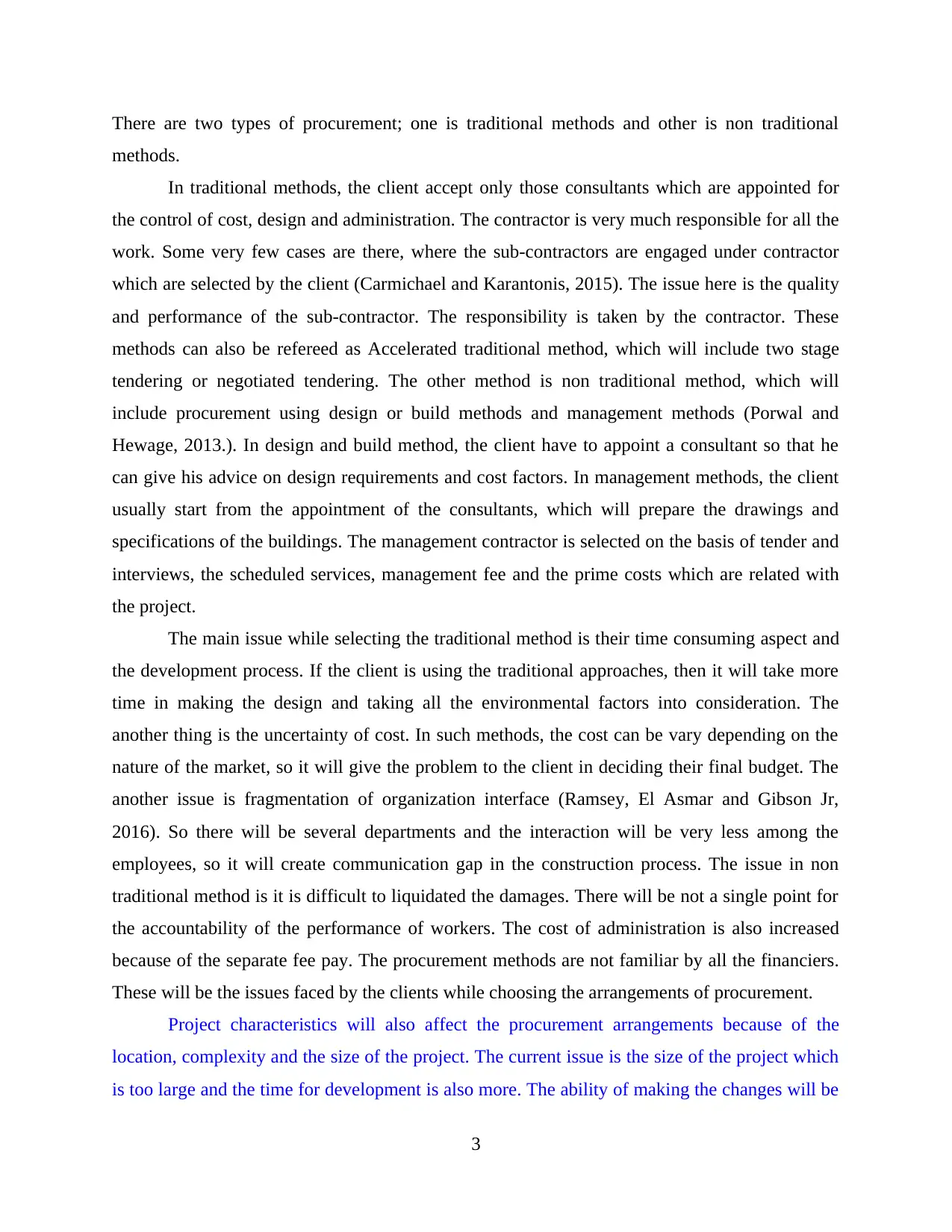
There are two types of procurement; one is traditional methods and other is non traditional
methods.
In traditional methods, the client accept only those consultants which are appointed for
the control of cost, design and administration. The contractor is very much responsible for all the
work. Some very few cases are there, where the sub-contractors are engaged under contractor
which are selected by the client (Carmichael and Karantonis, 2015). The issue here is the quality
and performance of the sub-contractor. The responsibility is taken by the contractor. These
methods can also be refereed as Accelerated traditional method, which will include two stage
tendering or negotiated tendering. The other method is non traditional method, which will
include procurement using design or build methods and management methods (Porwal and
Hewage, 2013.). In design and build method, the client have to appoint a consultant so that he
can give his advice on design requirements and cost factors. In management methods, the client
usually start from the appointment of the consultants, which will prepare the drawings and
specifications of the buildings. The management contractor is selected on the basis of tender and
interviews, the scheduled services, management fee and the prime costs which are related with
the project.
The main issue while selecting the traditional method is their time consuming aspect and
the development process. If the client is using the traditional approaches, then it will take more
time in making the design and taking all the environmental factors into consideration. The
another thing is the uncertainty of cost. In such methods, the cost can be vary depending on the
nature of the market, so it will give the problem to the client in deciding their final budget. The
another issue is fragmentation of organization interface (Ramsey, El Asmar and Gibson Jr,
2016). So there will be several departments and the interaction will be very less among the
employees, so it will create communication gap in the construction process. The issue in non
traditional method is it is difficult to liquidated the damages. There will be not a single point for
the accountability of the performance of workers. The cost of administration is also increased
because of the separate fee pay. The procurement methods are not familiar by all the financiers.
These will be the issues faced by the clients while choosing the arrangements of procurement.
Project characteristics will also affect the procurement arrangements because of the
location, complexity and the size of the project. The current issue is the size of the project which
is too large and the time for development is also more. The ability of making the changes will be
3
methods.
In traditional methods, the client accept only those consultants which are appointed for
the control of cost, design and administration. The contractor is very much responsible for all the
work. Some very few cases are there, where the sub-contractors are engaged under contractor
which are selected by the client (Carmichael and Karantonis, 2015). The issue here is the quality
and performance of the sub-contractor. The responsibility is taken by the contractor. These
methods can also be refereed as Accelerated traditional method, which will include two stage
tendering or negotiated tendering. The other method is non traditional method, which will
include procurement using design or build methods and management methods (Porwal and
Hewage, 2013.). In design and build method, the client have to appoint a consultant so that he
can give his advice on design requirements and cost factors. In management methods, the client
usually start from the appointment of the consultants, which will prepare the drawings and
specifications of the buildings. The management contractor is selected on the basis of tender and
interviews, the scheduled services, management fee and the prime costs which are related with
the project.
The main issue while selecting the traditional method is their time consuming aspect and
the development process. If the client is using the traditional approaches, then it will take more
time in making the design and taking all the environmental factors into consideration. The
another thing is the uncertainty of cost. In such methods, the cost can be vary depending on the
nature of the market, so it will give the problem to the client in deciding their final budget. The
another issue is fragmentation of organization interface (Ramsey, El Asmar and Gibson Jr,
2016). So there will be several departments and the interaction will be very less among the
employees, so it will create communication gap in the construction process. The issue in non
traditional method is it is difficult to liquidated the damages. There will be not a single point for
the accountability of the performance of workers. The cost of administration is also increased
because of the separate fee pay. The procurement methods are not familiar by all the financiers.
These will be the issues faced by the clients while choosing the arrangements of procurement.
Project characteristics will also affect the procurement arrangements because of the
location, complexity and the size of the project. The current issue is the size of the project which
is too large and the time for development is also more. The ability of making the changes will be
3
⊘ This is a preview!⊘
Do you want full access?
Subscribe today to unlock all pages.

Trusted by 1+ million students worldwide
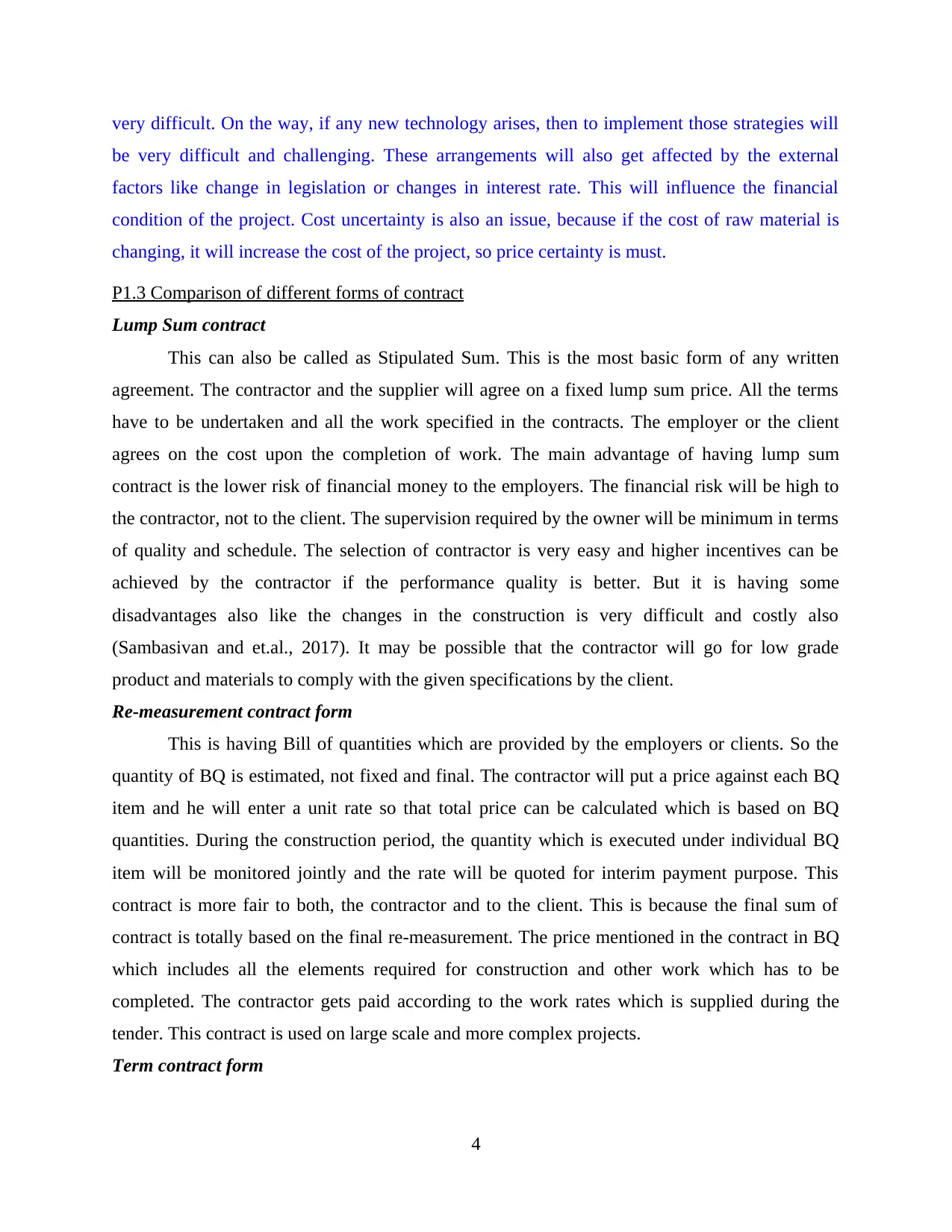
very difficult. On the way, if any new technology arises, then to implement those strategies will
be very difficult and challenging. These arrangements will also get affected by the external
factors like change in legislation or changes in interest rate. This will influence the financial
condition of the project. Cost uncertainty is also an issue, because if the cost of raw material is
changing, it will increase the cost of the project, so price certainty is must.
P1.3 Comparison of different forms of contract
Lump Sum contract
This can also be called as Stipulated Sum. This is the most basic form of any written
agreement. The contractor and the supplier will agree on a fixed lump sum price. All the terms
have to be undertaken and all the work specified in the contracts. The employer or the client
agrees on the cost upon the completion of work. The main advantage of having lump sum
contract is the lower risk of financial money to the employers. The financial risk will be high to
the contractor, not to the client. The supervision required by the owner will be minimum in terms
of quality and schedule. The selection of contractor is very easy and higher incentives can be
achieved by the contractor if the performance quality is better. But it is having some
disadvantages also like the changes in the construction is very difficult and costly also
(Sambasivan and et.al., 2017). It may be possible that the contractor will go for low grade
product and materials to comply with the given specifications by the client.
Re-measurement contract form
This is having Bill of quantities which are provided by the employers or clients. So the
quantity of BQ is estimated, not fixed and final. The contractor will put a price against each BQ
item and he will enter a unit rate so that total price can be calculated which is based on BQ
quantities. During the construction period, the quantity which is executed under individual BQ
item will be monitored jointly and the rate will be quoted for interim payment purpose. This
contract is more fair to both, the contractor and to the client. This is because the final sum of
contract is totally based on the final re-measurement. The price mentioned in the contract in BQ
which includes all the elements required for construction and other work which has to be
completed. The contractor gets paid according to the work rates which is supplied during the
tender. This contract is used on large scale and more complex projects.
Term contract form
4
be very difficult and challenging. These arrangements will also get affected by the external
factors like change in legislation or changes in interest rate. This will influence the financial
condition of the project. Cost uncertainty is also an issue, because if the cost of raw material is
changing, it will increase the cost of the project, so price certainty is must.
P1.3 Comparison of different forms of contract
Lump Sum contract
This can also be called as Stipulated Sum. This is the most basic form of any written
agreement. The contractor and the supplier will agree on a fixed lump sum price. All the terms
have to be undertaken and all the work specified in the contracts. The employer or the client
agrees on the cost upon the completion of work. The main advantage of having lump sum
contract is the lower risk of financial money to the employers. The financial risk will be high to
the contractor, not to the client. The supervision required by the owner will be minimum in terms
of quality and schedule. The selection of contractor is very easy and higher incentives can be
achieved by the contractor if the performance quality is better. But it is having some
disadvantages also like the changes in the construction is very difficult and costly also
(Sambasivan and et.al., 2017). It may be possible that the contractor will go for low grade
product and materials to comply with the given specifications by the client.
Re-measurement contract form
This is having Bill of quantities which are provided by the employers or clients. So the
quantity of BQ is estimated, not fixed and final. The contractor will put a price against each BQ
item and he will enter a unit rate so that total price can be calculated which is based on BQ
quantities. During the construction period, the quantity which is executed under individual BQ
item will be monitored jointly and the rate will be quoted for interim payment purpose. This
contract is more fair to both, the contractor and to the client. This is because the final sum of
contract is totally based on the final re-measurement. The price mentioned in the contract in BQ
which includes all the elements required for construction and other work which has to be
completed. The contractor gets paid according to the work rates which is supplied during the
tender. This contract is used on large scale and more complex projects.
Term contract form
4
Paraphrase This Document
Need a fresh take? Get an instant paraphrase of this document with our AI Paraphraser
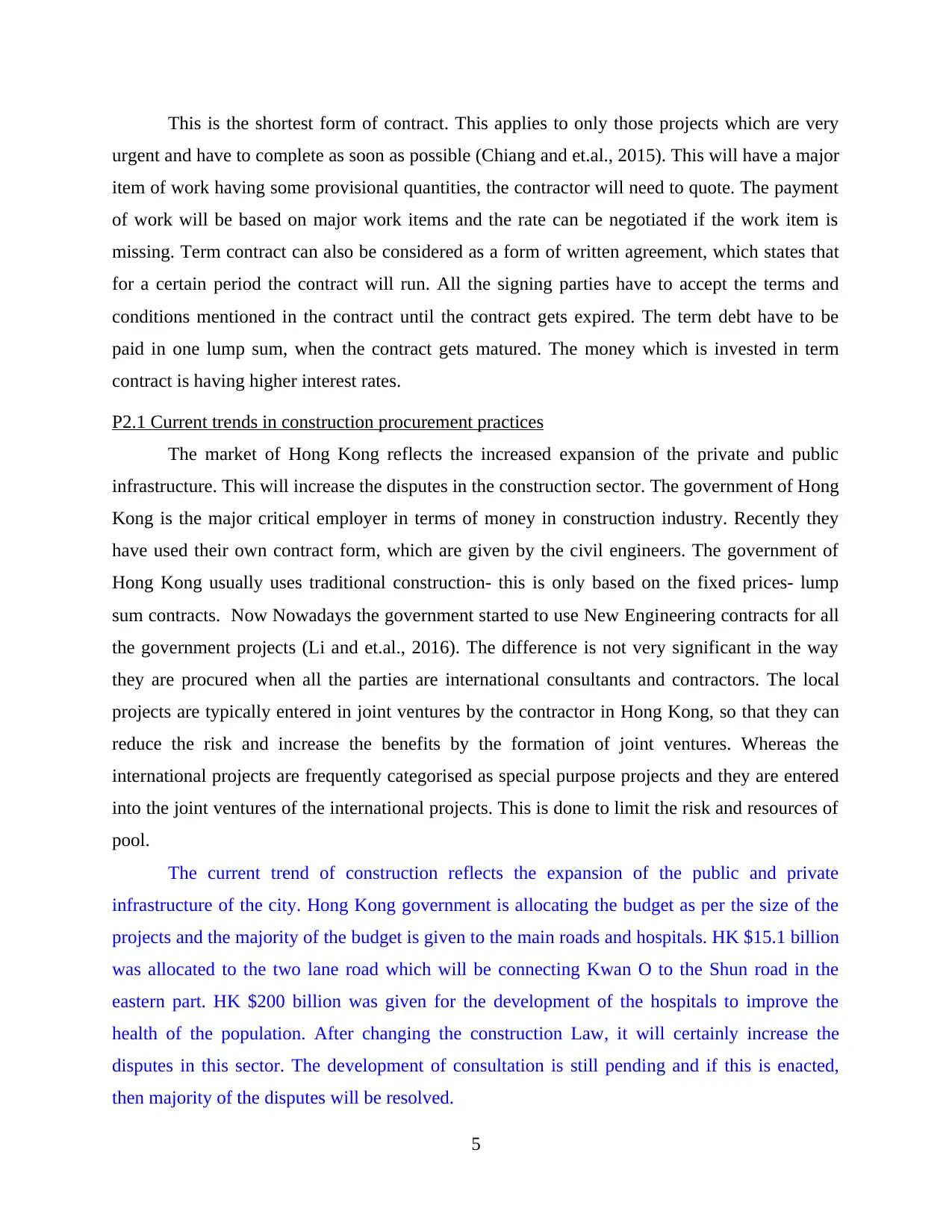
This is the shortest form of contract. This applies to only those projects which are very
urgent and have to complete as soon as possible (Chiang and et.al., 2015). This will have a major
item of work having some provisional quantities, the contractor will need to quote. The payment
of work will be based on major work items and the rate can be negotiated if the work item is
missing. Term contract can also be considered as a form of written agreement, which states that
for a certain period the contract will run. All the signing parties have to accept the terms and
conditions mentioned in the contract until the contract gets expired. The term debt have to be
paid in one lump sum, when the contract gets matured. The money which is invested in term
contract is having higher interest rates.
P2.1 Current trends in construction procurement practices
The market of Hong Kong reflects the increased expansion of the private and public
infrastructure. This will increase the disputes in the construction sector. The government of Hong
Kong is the major critical employer in terms of money in construction industry. Recently they
have used their own contract form, which are given by the civil engineers. The government of
Hong Kong usually uses traditional construction- this is only based on the fixed prices- lump
sum contracts. Now Nowadays the government started to use New Engineering contracts for all
the government projects (Li and et.al., 2016). The difference is not very significant in the way
they are procured when all the parties are international consultants and contractors. The local
projects are typically entered in joint ventures by the contractor in Hong Kong, so that they can
reduce the risk and increase the benefits by the formation of joint ventures. Whereas the
international projects are frequently categorised as special purpose projects and they are entered
into the joint ventures of the international projects. This is done to limit the risk and resources of
pool.
The current trend of construction reflects the expansion of the public and private
infrastructure of the city. Hong Kong government is allocating the budget as per the size of the
projects and the majority of the budget is given to the main roads and hospitals. HK $15.1 billion
was allocated to the two lane road which will be connecting Kwan O to the Shun road in the
eastern part. HK $200 billion was given for the development of the hospitals to improve the
health of the population. After changing the construction Law, it will certainly increase the
disputes in this sector. The development of consultation is still pending and if this is enacted,
then majority of the disputes will be resolved.
5
urgent and have to complete as soon as possible (Chiang and et.al., 2015). This will have a major
item of work having some provisional quantities, the contractor will need to quote. The payment
of work will be based on major work items and the rate can be negotiated if the work item is
missing. Term contract can also be considered as a form of written agreement, which states that
for a certain period the contract will run. All the signing parties have to accept the terms and
conditions mentioned in the contract until the contract gets expired. The term debt have to be
paid in one lump sum, when the contract gets matured. The money which is invested in term
contract is having higher interest rates.
P2.1 Current trends in construction procurement practices
The market of Hong Kong reflects the increased expansion of the private and public
infrastructure. This will increase the disputes in the construction sector. The government of Hong
Kong is the major critical employer in terms of money in construction industry. Recently they
have used their own contract form, which are given by the civil engineers. The government of
Hong Kong usually uses traditional construction- this is only based on the fixed prices- lump
sum contracts. Now Nowadays the government started to use New Engineering contracts for all
the government projects (Li and et.al., 2016). The difference is not very significant in the way
they are procured when all the parties are international consultants and contractors. The local
projects are typically entered in joint ventures by the contractor in Hong Kong, so that they can
reduce the risk and increase the benefits by the formation of joint ventures. Whereas the
international projects are frequently categorised as special purpose projects and they are entered
into the joint ventures of the international projects. This is done to limit the risk and resources of
pool.
The current trend of construction reflects the expansion of the public and private
infrastructure of the city. Hong Kong government is allocating the budget as per the size of the
projects and the majority of the budget is given to the main roads and hospitals. HK $15.1 billion
was allocated to the two lane road which will be connecting Kwan O to the Shun road in the
eastern part. HK $200 billion was given for the development of the hospitals to improve the
health of the population. After changing the construction Law, it will certainly increase the
disputes in this sector. The development of consultation is still pending and if this is enacted,
then majority of the disputes will be resolved.
5
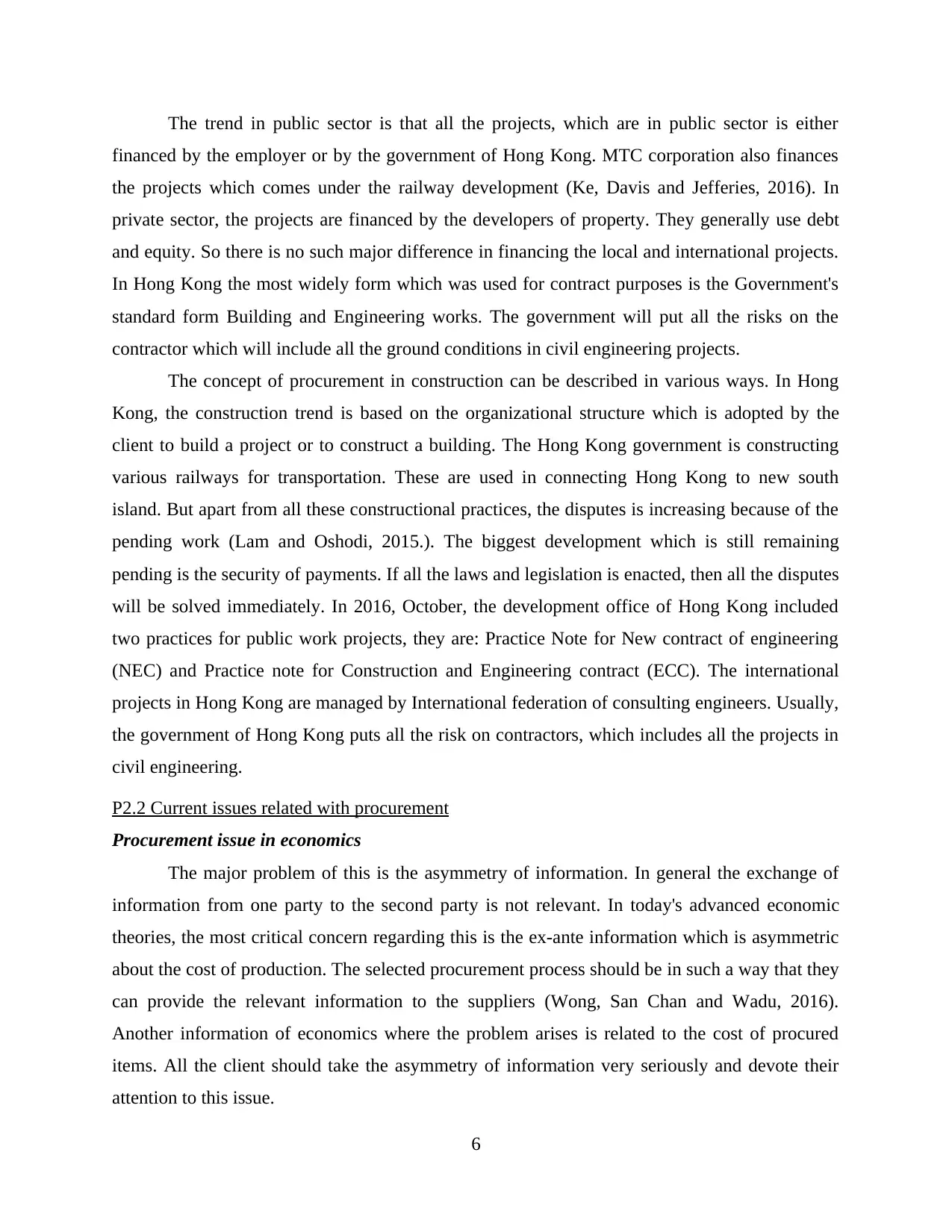
The trend in public sector is that all the projects, which are in public sector is either
financed by the employer or by the government of Hong Kong. MTC corporation also finances
the projects which comes under the railway development (Ke, Davis and Jefferies, 2016). In
private sector, the projects are financed by the developers of property. They generally use debt
and equity. So there is no such major difference in financing the local and international projects.
In Hong Kong the most widely form which was used for contract purposes is the Government's
standard form Building and Engineering works. The government will put all the risks on the
contractor which will include all the ground conditions in civil engineering projects.
The concept of procurement in construction can be described in various ways. In Hong
Kong, the construction trend is based on the organizational structure which is adopted by the
client to build a project or to construct a building. The Hong Kong government is constructing
various railways for transportation. These are used in connecting Hong Kong to new south
island. But apart from all these constructional practices, the disputes is increasing because of the
pending work (Lam and Oshodi, 2015.). The biggest development which is still remaining
pending is the security of payments. If all the laws and legislation is enacted, then all the disputes
will be solved immediately. In 2016, October, the development office of Hong Kong included
two practices for public work projects, they are: Practice Note for New contract of engineering
(NEC) and Practice note for Construction and Engineering contract (ECC). The international
projects in Hong Kong are managed by International federation of consulting engineers. Usually,
the government of Hong Kong puts all the risk on contractors, which includes all the projects in
civil engineering.
P2.2 Current issues related with procurement
Procurement issue in economics
The major problem of this is the asymmetry of information. In general the exchange of
information from one party to the second party is not relevant. In today's advanced economic
theories, the most critical concern regarding this is the ex-ante information which is asymmetric
about the cost of production. The selected procurement process should be in such a way that they
can provide the relevant information to the suppliers (Wong, San Chan and Wadu, 2016).
Another information of economics where the problem arises is related to the cost of procured
items. All the client should take the asymmetry of information very seriously and devote their
attention to this issue.
6
financed by the employer or by the government of Hong Kong. MTC corporation also finances
the projects which comes under the railway development (Ke, Davis and Jefferies, 2016). In
private sector, the projects are financed by the developers of property. They generally use debt
and equity. So there is no such major difference in financing the local and international projects.
In Hong Kong the most widely form which was used for contract purposes is the Government's
standard form Building and Engineering works. The government will put all the risks on the
contractor which will include all the ground conditions in civil engineering projects.
The concept of procurement in construction can be described in various ways. In Hong
Kong, the construction trend is based on the organizational structure which is adopted by the
client to build a project or to construct a building. The Hong Kong government is constructing
various railways for transportation. These are used in connecting Hong Kong to new south
island. But apart from all these constructional practices, the disputes is increasing because of the
pending work (Lam and Oshodi, 2015.). The biggest development which is still remaining
pending is the security of payments. If all the laws and legislation is enacted, then all the disputes
will be solved immediately. In 2016, October, the development office of Hong Kong included
two practices for public work projects, they are: Practice Note for New contract of engineering
(NEC) and Practice note for Construction and Engineering contract (ECC). The international
projects in Hong Kong are managed by International federation of consulting engineers. Usually,
the government of Hong Kong puts all the risk on contractors, which includes all the projects in
civil engineering.
P2.2 Current issues related with procurement
Procurement issue in economics
The major problem of this is the asymmetry of information. In general the exchange of
information from one party to the second party is not relevant. In today's advanced economic
theories, the most critical concern regarding this is the ex-ante information which is asymmetric
about the cost of production. The selected procurement process should be in such a way that they
can provide the relevant information to the suppliers (Wong, San Chan and Wadu, 2016).
Another information of economics where the problem arises is related to the cost of procured
items. All the client should take the asymmetry of information very seriously and devote their
attention to this issue.
6
⊘ This is a preview!⊘
Do you want full access?
Subscribe today to unlock all pages.

Trusted by 1+ million students worldwide
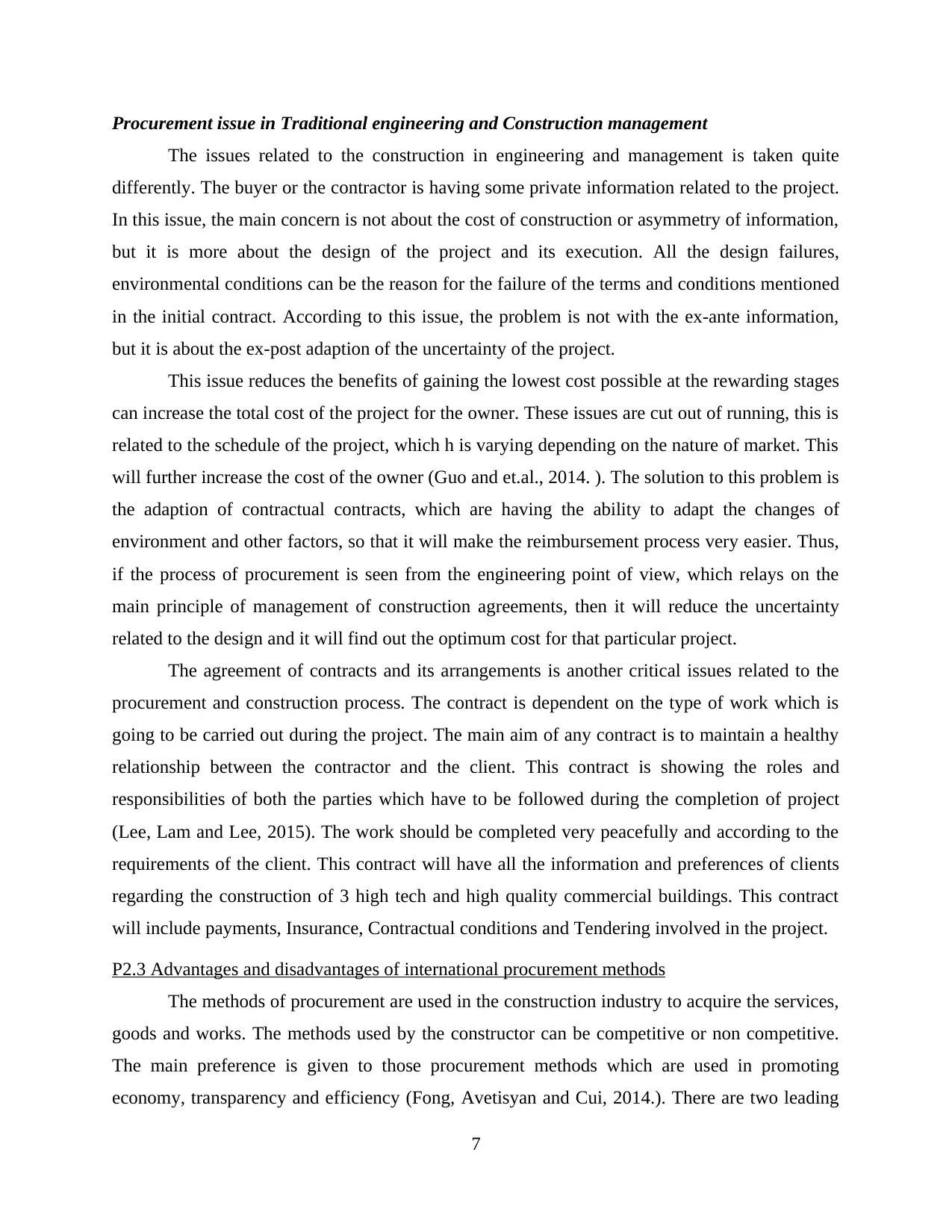
Procurement issue in Traditional engineering and Construction management
The issues related to the construction in engineering and management is taken quite
differently. The buyer or the contractor is having some private information related to the project.
In this issue, the main concern is not about the cost of construction or asymmetry of information,
but it is more about the design of the project and its execution. All the design failures,
environmental conditions can be the reason for the failure of the terms and conditions mentioned
in the initial contract. According to this issue, the problem is not with the ex-ante information,
but it is about the ex-post adaption of the uncertainty of the project.
This issue reduces the benefits of gaining the lowest cost possible at the rewarding stages
can increase the total cost of the project for the owner. These issues are cut out of running, this is
related to the schedule of the project, which h is varying depending on the nature of market. This
will further increase the cost of the owner (Guo and et.al., 2014. ). The solution to this problem is
the adaption of contractual contracts, which are having the ability to adapt the changes of
environment and other factors, so that it will make the reimbursement process very easier. Thus,
if the process of procurement is seen from the engineering point of view, which relays on the
main principle of management of construction agreements, then it will reduce the uncertainty
related to the design and it will find out the optimum cost for that particular project.
The agreement of contracts and its arrangements is another critical issues related to the
procurement and construction process. The contract is dependent on the type of work which is
going to be carried out during the project. The main aim of any contract is to maintain a healthy
relationship between the contractor and the client. This contract is showing the roles and
responsibilities of both the parties which have to be followed during the completion of project
(Lee, Lam and Lee, 2015). The work should be completed very peacefully and according to the
requirements of the client. This contract will have all the information and preferences of clients
regarding the construction of 3 high tech and high quality commercial buildings. This contract
will include payments, Insurance, Contractual conditions and Tendering involved in the project.
P2.3 Advantages and disadvantages of international procurement methods
The methods of procurement are used in the construction industry to acquire the services,
goods and works. The methods used by the constructor can be competitive or non competitive.
The main preference is given to those procurement methods which are used in promoting
economy, transparency and efficiency (Fong, Avetisyan and Cui, 2014.). There are two leading
7
The issues related to the construction in engineering and management is taken quite
differently. The buyer or the contractor is having some private information related to the project.
In this issue, the main concern is not about the cost of construction or asymmetry of information,
but it is more about the design of the project and its execution. All the design failures,
environmental conditions can be the reason for the failure of the terms and conditions mentioned
in the initial contract. According to this issue, the problem is not with the ex-ante information,
but it is about the ex-post adaption of the uncertainty of the project.
This issue reduces the benefits of gaining the lowest cost possible at the rewarding stages
can increase the total cost of the project for the owner. These issues are cut out of running, this is
related to the schedule of the project, which h is varying depending on the nature of market. This
will further increase the cost of the owner (Guo and et.al., 2014. ). The solution to this problem is
the adaption of contractual contracts, which are having the ability to adapt the changes of
environment and other factors, so that it will make the reimbursement process very easier. Thus,
if the process of procurement is seen from the engineering point of view, which relays on the
main principle of management of construction agreements, then it will reduce the uncertainty
related to the design and it will find out the optimum cost for that particular project.
The agreement of contracts and its arrangements is another critical issues related to the
procurement and construction process. The contract is dependent on the type of work which is
going to be carried out during the project. The main aim of any contract is to maintain a healthy
relationship between the contractor and the client. This contract is showing the roles and
responsibilities of both the parties which have to be followed during the completion of project
(Lee, Lam and Lee, 2015). The work should be completed very peacefully and according to the
requirements of the client. This contract will have all the information and preferences of clients
regarding the construction of 3 high tech and high quality commercial buildings. This contract
will include payments, Insurance, Contractual conditions and Tendering involved in the project.
P2.3 Advantages and disadvantages of international procurement methods
The methods of procurement are used in the construction industry to acquire the services,
goods and works. The methods used by the constructor can be competitive or non competitive.
The main preference is given to those procurement methods which are used in promoting
economy, transparency and efficiency (Fong, Avetisyan and Cui, 2014.). There are two leading
7
Paraphrase This Document
Need a fresh take? Get an instant paraphrase of this document with our AI Paraphraser
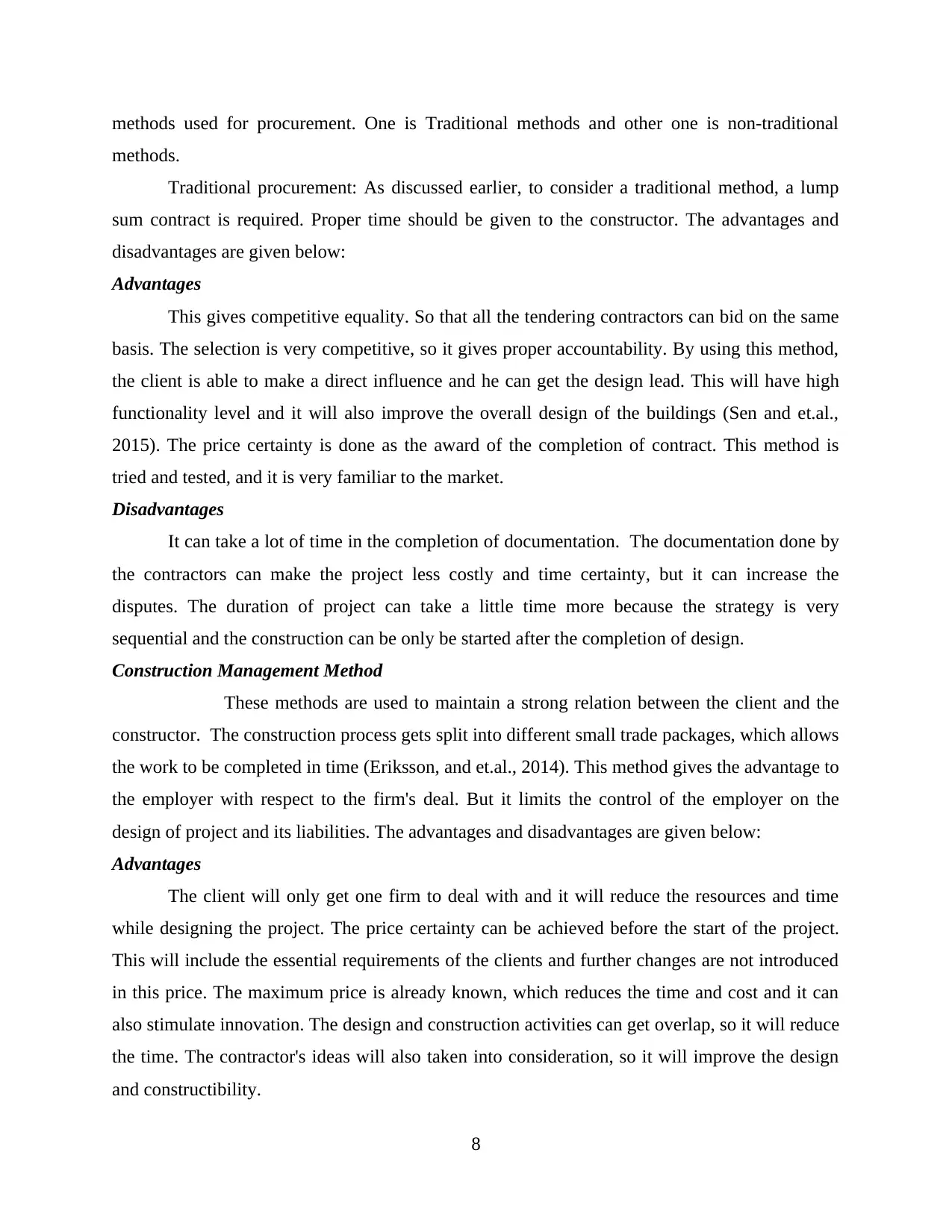
methods used for procurement. One is Traditional methods and other one is non-traditional
methods.
Traditional procurement: As discussed earlier, to consider a traditional method, a lump
sum contract is required. Proper time should be given to the constructor. The advantages and
disadvantages are given below:
Advantages
This gives competitive equality. So that all the tendering contractors can bid on the same
basis. The selection is very competitive, so it gives proper accountability. By using this method,
the client is able to make a direct influence and he can get the design lead. This will have high
functionality level and it will also improve the overall design of the buildings (Sen and et.al.,
2015). The price certainty is done as the award of the completion of contract. This method is
tried and tested, and it is very familiar to the market.
Disadvantages
It can take a lot of time in the completion of documentation. The documentation done by
the contractors can make the project less costly and time certainty, but it can increase the
disputes. The duration of project can take a little time more because the strategy is very
sequential and the construction can be only be started after the completion of design.
Construction Management Method
These methods are used to maintain a strong relation between the client and the
constructor. The construction process gets split into different small trade packages, which allows
the work to be completed in time (Eriksson, and et.al., 2014). This method gives the advantage to
the employer with respect to the firm's deal. But it limits the control of the employer on the
design of project and its liabilities. The advantages and disadvantages are given below:
Advantages
The client will only get one firm to deal with and it will reduce the resources and time
while designing the project. The price certainty can be achieved before the start of the project.
This will include the essential requirements of the clients and further changes are not introduced
in this price. The maximum price is already known, which reduces the time and cost and it can
also stimulate innovation. The design and construction activities can get overlap, so it will reduce
the time. The contractor's ideas will also taken into consideration, so it will improve the design
and constructibility.
8
methods.
Traditional procurement: As discussed earlier, to consider a traditional method, a lump
sum contract is required. Proper time should be given to the constructor. The advantages and
disadvantages are given below:
Advantages
This gives competitive equality. So that all the tendering contractors can bid on the same
basis. The selection is very competitive, so it gives proper accountability. By using this method,
the client is able to make a direct influence and he can get the design lead. This will have high
functionality level and it will also improve the overall design of the buildings (Sen and et.al.,
2015). The price certainty is done as the award of the completion of contract. This method is
tried and tested, and it is very familiar to the market.
Disadvantages
It can take a lot of time in the completion of documentation. The documentation done by
the contractors can make the project less costly and time certainty, but it can increase the
disputes. The duration of project can take a little time more because the strategy is very
sequential and the construction can be only be started after the completion of design.
Construction Management Method
These methods are used to maintain a strong relation between the client and the
constructor. The construction process gets split into different small trade packages, which allows
the work to be completed in time (Eriksson, and et.al., 2014). This method gives the advantage to
the employer with respect to the firm's deal. But it limits the control of the employer on the
design of project and its liabilities. The advantages and disadvantages are given below:
Advantages
The client will only get one firm to deal with and it will reduce the resources and time
while designing the project. The price certainty can be achieved before the start of the project.
This will include the essential requirements of the clients and further changes are not introduced
in this price. The maximum price is already known, which reduces the time and cost and it can
also stimulate innovation. The design and construction activities can get overlap, so it will reduce
the time. The contractor's ideas will also taken into consideration, so it will improve the design
and constructibility.
8
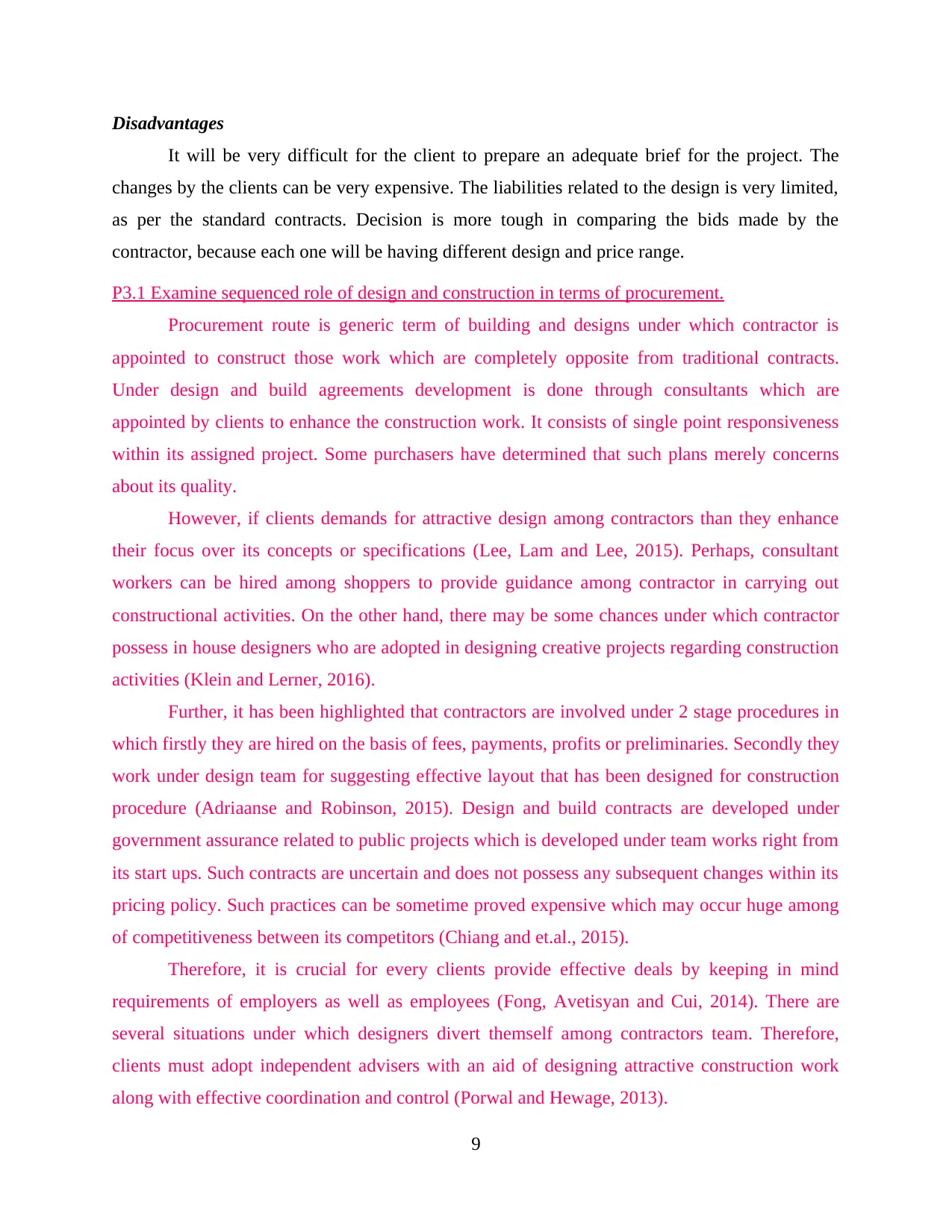
Disadvantages
It will be very difficult for the client to prepare an adequate brief for the project. The
changes by the clients can be very expensive. The liabilities related to the design is very limited,
as per the standard contracts. Decision is more tough in comparing the bids made by the
contractor, because each one will be having different design and price range.
P3.1 Examine sequenced role of design and construction in terms of procurement.
Procurement route is generic term of building and designs under which contractor is
appointed to construct those work which are completely opposite from traditional contracts.
Under design and build agreements development is done through consultants which are
appointed by clients to enhance the construction work. It consists of single point responsiveness
within its assigned project. Some purchasers have determined that such plans merely concerns
about its quality.
However, if clients demands for attractive design among contractors than they enhance
their focus over its concepts or specifications (Lee, Lam and Lee, 2015). Perhaps, consultant
workers can be hired among shoppers to provide guidance among contractor in carrying out
constructional activities. On the other hand, there may be some chances under which contractor
possess in house designers who are adopted in designing creative projects regarding construction
activities (Klein and Lerner, 2016).
Further, it has been highlighted that contractors are involved under 2 stage procedures in
which firstly they are hired on the basis of fees, payments, profits or preliminaries. Secondly they
work under design team for suggesting effective layout that has been designed for construction
procedure (Adriaanse and Robinson, 2015). Design and build contracts are developed under
government assurance related to public projects which is developed under team works right from
its start ups. Such contracts are uncertain and does not possess any subsequent changes within its
pricing policy. Such practices can be sometime proved expensive which may occur huge among
of competitiveness between its competitors (Chiang and et.al., 2015).
Therefore, it is crucial for every clients provide effective deals by keeping in mind
requirements of employers as well as employees (Fong, Avetisyan and Cui, 2014). There are
several situations under which designers divert themself among contractors team. Therefore,
clients must adopt independent advisers with an aid of designing attractive construction work
along with effective coordination and control (Porwal and Hewage, 2013).
9
It will be very difficult for the client to prepare an adequate brief for the project. The
changes by the clients can be very expensive. The liabilities related to the design is very limited,
as per the standard contracts. Decision is more tough in comparing the bids made by the
contractor, because each one will be having different design and price range.
P3.1 Examine sequenced role of design and construction in terms of procurement.
Procurement route is generic term of building and designs under which contractor is
appointed to construct those work which are completely opposite from traditional contracts.
Under design and build agreements development is done through consultants which are
appointed by clients to enhance the construction work. It consists of single point responsiveness
within its assigned project. Some purchasers have determined that such plans merely concerns
about its quality.
However, if clients demands for attractive design among contractors than they enhance
their focus over its concepts or specifications (Lee, Lam and Lee, 2015). Perhaps, consultant
workers can be hired among shoppers to provide guidance among contractor in carrying out
constructional activities. On the other hand, there may be some chances under which contractor
possess in house designers who are adopted in designing creative projects regarding construction
activities (Klein and Lerner, 2016).
Further, it has been highlighted that contractors are involved under 2 stage procedures in
which firstly they are hired on the basis of fees, payments, profits or preliminaries. Secondly they
work under design team for suggesting effective layout that has been designed for construction
procedure (Adriaanse and Robinson, 2015). Design and build contracts are developed under
government assurance related to public projects which is developed under team works right from
its start ups. Such contracts are uncertain and does not possess any subsequent changes within its
pricing policy. Such practices can be sometime proved expensive which may occur huge among
of competitiveness between its competitors (Chiang and et.al., 2015).
Therefore, it is crucial for every clients provide effective deals by keeping in mind
requirements of employers as well as employees (Fong, Avetisyan and Cui, 2014). There are
several situations under which designers divert themself among contractors team. Therefore,
clients must adopt independent advisers with an aid of designing attractive construction work
along with effective coordination and control (Porwal and Hewage, 2013).
9
⊘ This is a preview!⊘
Do you want full access?
Subscribe today to unlock all pages.

Trusted by 1+ million students worldwide
1 out of 19
Related Documents
Your All-in-One AI-Powered Toolkit for Academic Success.
+13062052269
info@desklib.com
Available 24*7 on WhatsApp / Email
![[object Object]](/_next/static/media/star-bottom.7253800d.svg)
Unlock your academic potential
Copyright © 2020–2025 A2Z Services. All Rights Reserved. Developed and managed by ZUCOL.





